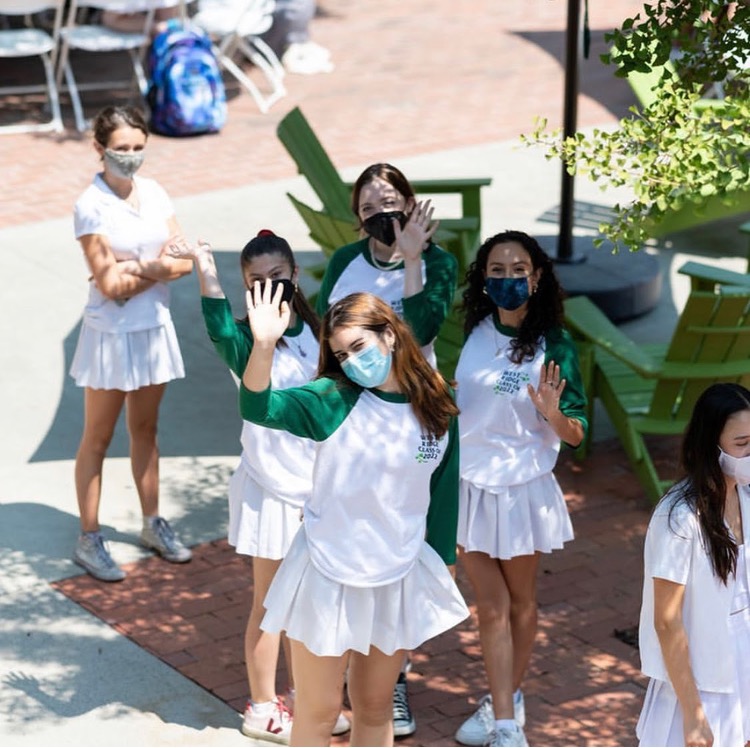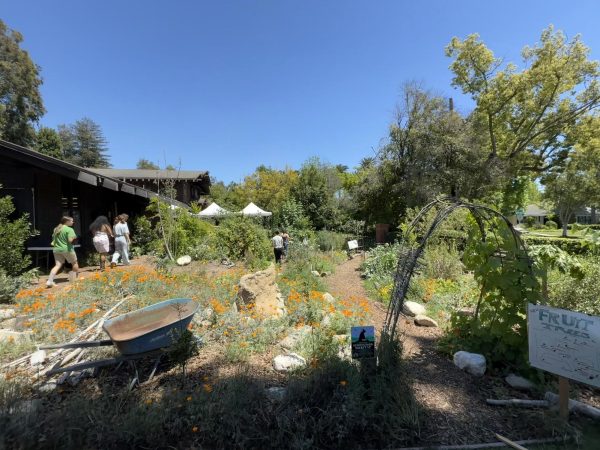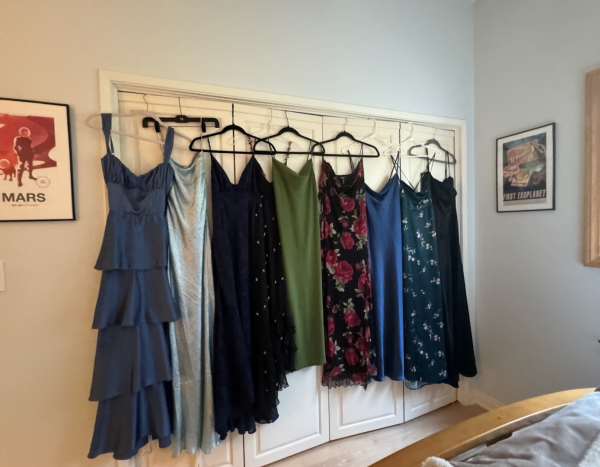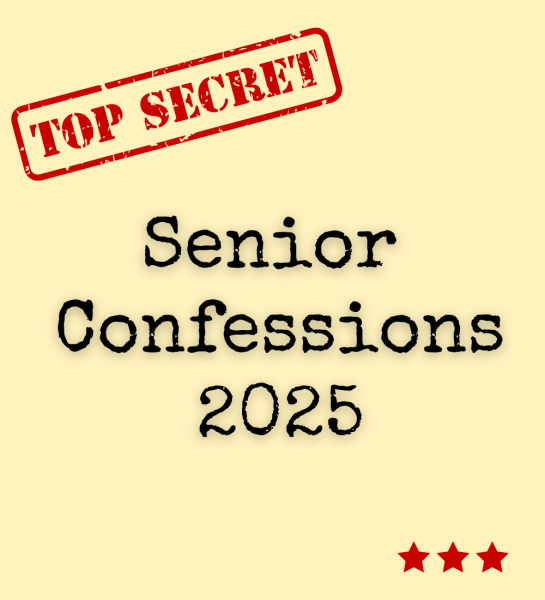2021-22 School Year Ushers in a New Normal, Covid-Style
As part of Westridge’s protocol, Westridge students wearing masks on Convocation. (@westridgeschool)
The Westridge community is getting good at COVID life—or at least getting used to it. Although some quibbling and grumbling inevitably persist, the new school year has seen a growing level of comfort with the omnipresent COVID-19 protocols that are the “new normal” in 2021.
The consternation and angst surrounding mask-wearing, daily Magnus app surveys, weekly nasal swabs, seating charts, and mandatory vaccination requirements that marked students’ return to school last spring have given way to acceptance, or, at the very least, resignation. Likewise, fear of contagion at school has diminished to the point that most students feel safe attending school in person, due in large part to Westridge’s extensive COVID protocols.
“Yeah, I feel very safe,” said Anna K. ’24. “Just knowing that most people are vaccinated and everybody’s getting a weekly COVID test that has to be negative before coming to school, and also knowing that everybody’s masking and eating outside is really helpful to me—it makes me feel really comfortable.”
Molly M. ’22 agreed. “As a vaccinated individual, I definitely feel safe on campus. I feel like everyone’s really good about wearing their masks over their noses in class, and outdoors is the only time I see people without them when we’re eating.”
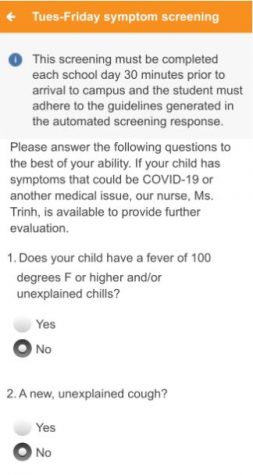
Students’ feelings of safety on campus seem justified since there have been no COVID outbreaks this year. This is a win for Westridge administrators, who are constantly challenged with finding the right balance between enforcing safe practices while optimizing normalcy for the community. Still, some of the push-pull controversy between community members who believe that COVID restrictions aren’t strict enough while others think the requirements are too burdensome remains.
“My mom thinks that Westridge should be doing more—like, way more,” Isla R. ’25 said. “She’s always on me about wearing a mask and about other people wearing a mask. She definitely thinks there should be an online school option.”
Westridge’s unpopular contact tracing measures have been accused of being onerous and ineffective. This year, the administration requires faculty to implement seating charts and lunch groupings. In each classroom, teachers enforce semi-permanent seating arrangements with the intention of keeping the number of close contacts of students as low as possible. Similarly, students are expected to sit in the same small groups of 5-10 people during lunch. Many feel that this approach to contact tracing is more performative than effective because of the inevitable exposure to people outside of classroom seating charts and lunch groups.
“It just didn’t make sense to me,” Pauline K. ’25 said. “I don’t have a problem with [seating charts], but I don’t think they’re doing anything.”
To some, the advantage of being able to contact trace in the event of a COVID outbreak is simply not worth the daily headache of seating charts and lunch groups. Moreover, students argue that regular contact with the wider Westridge population during passing periods renders the limited groupings moot.
Gary Baldwin, Director of Upper School, firmly rejects the idea that limiting students’ close contacts is more trouble than it’s worth. “That argument doesn’t carry a lot of weight with me,” he said. “It’s sort of like saying just because people die in car crashes, it doesn’t mean that it’s not a good idea to wear your seatbelt, right?”
Mr. Baldwin also noted that brief interaction with other students during passing periods does not rise to the level of “close contact,” which the Pasadena Department of Public Health defines as being within six feet of someone for more than 15 minutes.
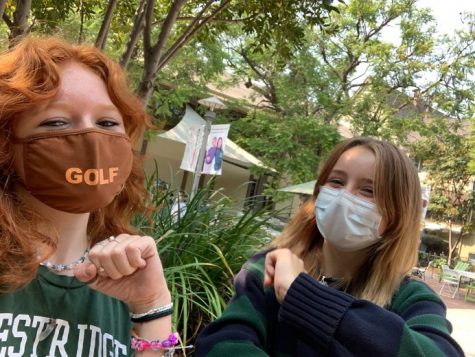
Mr. Baldwin points to the invaluable nature of a reliable record of close contacts in the event of a positive COVID test. “Trying to nip it in the bud by knowing, ‘Okay, here’s one case, here’s all the people [who were near that person], let’s make sure that all those people get tested,’ is the safest way to do it. And unfortunately, that means the inconvenience of seating charts, lunch areas, and all the rest of it,” he concluded.
Inconvenience aside, Westridge’s position to err on the side of caution may protect students physically even if it contributes to a sense of isolation. Molly M. ’22 objects to the limited lunch groups. “It defeats the purpose of being in-person and getting to hang out with people, you know, when we don’t get to actually hang out with people we want to,” she said.
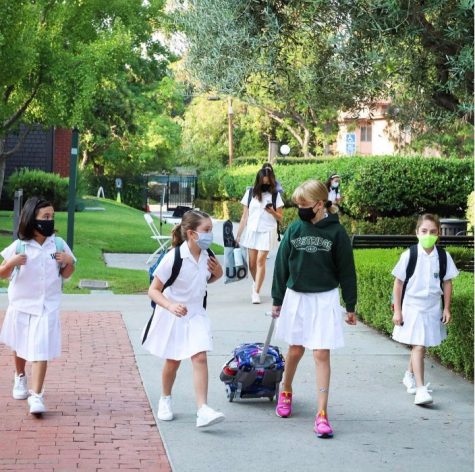
After nearly a year of distance learning, students are clearly craving connection with their peers, and students and faculty alike are looking forward to a time when larger gatherings can be held altogether in person. The much-anticipated celebratory nature or unifying school spirit that typically accompanies hallowed all-school events like Convocation and Greek and Roman initiation have been absent in this year’s remote Zoom-view format, causing the events to fall flat.
Assemblies also lose emotional immediacy in the digital format. Students like Pauline K. ’25 find that emotions don’t always translate through a screen, making the cherished give-and-take dialog with Student Voices presenters difficult. Still, most agree that on-campus learning, even while imperfectly connected, is vastly preferable to the totally disconnected experience of distance learning.
“I definitely miss all the spirit things that we used to do, like town halls, assemblies, and Greek and Roman initiations,” said Anna K. ’24 agreed “It’s still fun, but it’s obviously less of a big thing, which I really miss about it. But I think that especially during a global pandemic we need to make sure that we’re being safe, so I’m completely for all the protocols.”

Reed is a senior, and this is her fifth year on Spyglass and her third year juggling her roles as Editor, Website Manager, and Website Designer. Outside...

















![Dr. Zanita Kelly, Director of Lower and Middle School, pictured above, and the rest of Westridge Administration were instrumental to providing Westridge faculty and staff the support they needed after the Eaton fire. "[Teachers] are part of the community," said Dr. Kelly. "Just like our families and students."](https://westridgespyglass.org/wp-content/uploads/2025/03/dr.-kellyyy-1-e1748143600809.png)











































